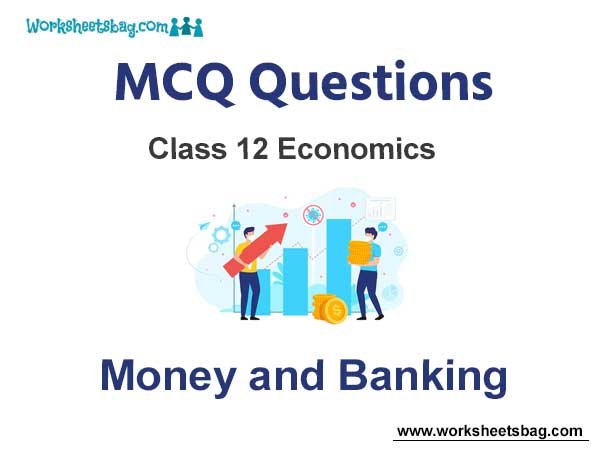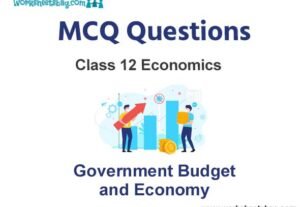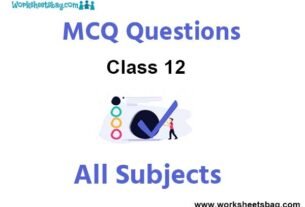Please refer to Money and Banking MCQ Questions Class 12 Economics below. These MCQ questions for Class 12 Economics with answers have been designed as per the latest NCERT, CBSE books, and syllabus issued for the current academic year. These objective questions for Money and Banking will help you to prepare for the exams and get more marks.
Money and Banking MCQ Questions Class 12 Economics
Please see solved MCQ Questions for Money and Banking in Class 12 Economics. All questions and answers have been prepared by expert faculty of standard 12 based on the latest examination guidelines.
MCQ Questions Class 12 Economics Money and Banking
Question. Which one of the following is a quantitative tool of credit control used by RBI?
(a) Bank rate policy
(b) Marginal requirements
(c) Moral suasion
(d) Direct action
Answer
A
Question. Which of the following is not the function of the Central Bank?
(a) Banking facilities to government
(b) Lending to commercial banks
(c) Banking facilities to public
(d) Lending to government
Answer
C
Question. What would be the total money creation in the economy, If initial fresh deposits with banks = Rs 50,000 and LRR = 20%.
(a) Rs 2,50,000
(b) Rs 5,00,000
(c) Rs 10,00,000
(d) Rs 12,00,000
Answer
A
Question. Which Bank is authorised to issue currency?
(a) Central Bank
(b) Commercial Bank
(c) Cooperative Bank
(d) Scheduled Bank
Answer
A
Question. ________ is the main source of money supply in an economy.
(a) Central Bank
(b) Commercial Banks
(c) Government
(d) Both (a) and (b)
Answer
D
Question. Which of the following functions of money simplifies the process of borrowing and lending?
(a) Store of value
(b) Medium of exchange
(c) Standard of deferred payments
(d) Unit of value
Answer
C
Question. Which of the following is not included in money supply?
(a) Currency held by public
(b) Inter-bank-deposits
(c) Demand deposits in Banks
(d) Saving deposits with post office banks.
Answer
B
Question. M1 of money supply does not include.
(a) Currency held by public
(b) Other deposits in RBI
(c) Demand deposits with the Commercial Banks
(d) Net time deposits with banks
Answer
D
Question. Measuring the value of goods and services refers to which of the following functions of money?
(a) Store of value
(b) Unit of value
(c) Standard of deferred payments
(d) Medium of exchange
Answer
B
Question. Which one of the following is a qualitative measure of credit control by the Central Bank?
(a) Bank rate
(b) Open market operations
(c) Marginal requirements
(d) Cash reserve ratio
Answer
C
Question. The short term borrowing rate at which Reserve Bank of India borrows money from Commercial Banks is called ________.
(a) Bank rate
(b) Discount rate
(c) Repo rate
(d) Reverse repo rate
Answer
D
Question. The ratio of total deposits that a commercial Banks has to keep with Reserve Bank of India is called
(a) Deposit ratio
(b) Cash reserve ratio
(c) Legal reserve ratio
(d) Statutory liquidity ratio
Answer
B
Question. ________ refers to the proportion of total deposits which Banks are required to keep in the form of reserves with themselves.
(a) Cash deposit ratio
(b) Statutory liquidity ratio
(c) Bank rate
(d) Reserve deposit ratio
Answer
D
Question. The rate at which Commercial Banks borrow from Central Bank is called ________.
(a) Bank rate
(b) Legal reserve ratio
(c) Reverse repo rate
(d) Cash reserve ratio
Answer
A
Question. Who regulates money supply in India?
(a) Government of India
(b) Reserve Bank of India
(c) Planning Commission
(d) NITI Aayog
Answer
B
Question. __________ is the main source of money supply in an economy.
(a) Central Bank
(b) Commercial Banks
(c) Government
(d) Both a and b
Answer
D
Question. Money supply is a ________ concept.
(a) Flow
(b) Stock
(c) Variable
(d) All of these
Answer
B
Question. Supply of money refers to quantity of money –
(a) As on 31st March
(b) During any specified period of time
(c) As on any point of time
(d) During a fiscal year
Answer
C
Question. Money supply includes _________
(a) All deposits in bank
(b) Only demand deposits in banks
(c) Only time deposits in banks
(d) Currency with the banks
Answer
B
Question. The creation of ________ is called credit creation.
(a) time deposits
(b) primary deposits
(c) secondary deposits
(d) none of these
Answer
C
Question. _________ are called legal tenders.
(a) demand deposits
(b) time deposits
(c) inter-bank deposits
(d) currency notes and coins
Answer
D
Question. _______ is the primary function of money.
(a) transfer of value
(b) medium of exchange
(c) standard of deferred payment
(d) store of value
Answer
B
Question. Limitation of barter system of exchange
(a) lack of unit of value
(b) lack of store of value
(c) lack of standard of deferred payments
(d) all of these
Answer
D
Question. High powered money includes –
(a) currency and demand deposits
(b) demand deposits and saving deposits
(c) currency held by public and cash reserves with banks
(d) none of these
Answer
C
Question: Central bank is an apex bank of the country that:
a) Controls the entire banking system of the country
b) Issues currency
c) Acts as a banker to the government
d) All of these
Answer
D
Question: Credit control means:
a) Contraction of credit only
b) Extension of credit only
c) Extension and contraction of money supply
d) None of these
Answer
C
Question: Supply of money refers to quantity of money –
a) As on 31st March
b) During any specified period of time
c) As on any point of time
d) During a fiscal year
Answer
C
Question: Which of the following is not the instrument of credit control?
a) CRR
b) SLR
c) Repo rate
d) Managed floating
Answer
D
Question: The minimum percentage of a bank’s total deposits which is required to be kept with the RBI is called:
a) CRR
b) Repo rate
c) SLR
d) Reverse Repo Rate
Answer
A
Question: Money supply includes _________
a) All deposits in bank
b) Only demand deposits in banks
c) Only time deposits in banks
d) Currency with the banks
Answer
B
Question: Which of the following is the component of M1 measure of money supply?
a) Time deposit
b) Bill of exchange
c) Treasury bill
d) None of these
Answer
D
Question: Full- bodied money is that money, whose money value and commodity value are:
a) Equal
b) Proportionately equal
c) Different
d) None of these
Answer
A
Question: Barter system refers to that system where in:
a) Goods are exchanged for goods
b) Goods are not exchanged at all
c) Goods are exchanged for domestic currency
d) Goods are exchanged for foreign currency
Answer
A
Question: Which of the following leads to increase in AD ?
a) Fall in imports
b) Increase in investment expenditure
c) Increase in government expenditure
d) All of these
Answer
D
Question: __________ is the main source of money supply in an economy.
a) Central Bank
b) Commercial Banks
c) Government
d) Both a and b
Answer
D
Question: A commercial bank is a bank that:
a) Gives long-term loans
b) Creates credit
c) Gives short-term loans
d) All of these
Answer
D
Question: Which of the following is not concerned with banking organization?
a) Bank rate
b) Fiscal deficit
c) Credit creation
d) Cash reserve ratio
Answer
B
Question: _______ is the primary function of money.
a) transfer of value
b) medium of exchange
c) standard of deferred payment
d) store of value
Answer
B
Question: The creation of ________ is called credit creation.
a) time deposits
b) primary deposits
c) secondary deposits
d) none of these
Answer
C



